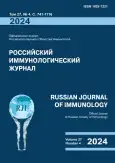VDR gene polymorphisms rs731236 and rsS2228570 affect vitamin D levels in people of the Kaliningrad region
- Authors: Bograya M.M.1, Vulf M.A.1, Safiullina L.A.1, Paskidov D.V.1, Shnar V.A.1, Gazatova N.D.1, Mikhailova L.V.1, Litvinova L.S.1
-
Affiliations:
- Immanuel Kant Baltic Federal University
- Issue: Vol 27, No 4 (2024)
- Pages: 995-1000
- Section: SHORT COMMUNICATIONS
- URL: https://journal-vniispk.ru/1028-7221/article/view/267918
- DOI: https://doi.org/10.46235/1028-7221-16881-VGP
- ID: 267918
Cite item
Full Text
Abstract
Vitamin D is an essential micronutrient that is involved in numerous biological processes. It not only keeps bones healthy, but also has a protective effect on the cardiovascular system, the pancreas and fatty tissue. Around 50% of the world’s population suffers from vitamin D deficiency or insufficiency. The prevalence of these diseases is significantly higher in obese people, regardless of age and place of residence. The presence of polymorphisms in the VDR gene (vitamin D receptor) can explain individual differences in the concentration of vitamin D 25(OH) in blood serum. Of particular interest are the effects of the polymorphisms rs731236 and rs2228570 on vitamin levels. Thus, the VDR polymorphism rs731236 is a synonymous substitution, whereas the polymorphism rs2228570 is a non-synonymous substitution. The article investigated the polymorphisms of the VDR gene rs2228570 (T/C), rs731236 (T/C) and determined their association with blood vitamin D levels in people from the Kaliningrad region with different body mass index (BMI). The material for the study was venous blood taken in the morning on an empty stomach from 232 people (mean age 50±13.5 years, 103 men and 129 women). The vitamin D content in the blood was determined by ELISA and the polymorphisms of the VDR gene were analyzed by PCR.
In individuals with a BMI > 30 kg/m2, changes in the lipid profile and liver function tests were recorded. The vitamin D level did not depend on the BMI of the study participants. Significant changes in blood vitamin D levels were found depending on the distribution of the VDR genotype. Vitamin D levels were higher in individuals with the CC genotype than in the TT and CT genotypes of the rs2228570 polymorphism and did not depend on BMI. In contrast, the presence of the rs731236 polymorphism in the VDR gene is associated with BMI. In obesity, vitamin D levels are therefore only reduced in people with the TT genotype of the rs731236 polymorphism, but not in people with the CC and TC genotype.
Keywords
Full Text
##article.viewOnOriginalSite##About the authors
M. M. Bograya
Immanuel Kant Baltic Federal University
Email: larisalitvinova@yandex.ru
Junior Research Associate, Centre of Immunology and Cell Biotechnology Institute of Medicine and Life Sciences
Russian Federation, KaliningradM. A. Vulf
Immanuel Kant Baltic Federal University
Email: larisalitvinova@yandex.ru
PhD (Biology), Senior Research Associate, Centre of Immunology and Cell Biotechnology Institute of Medicine and Life Sciences
Russian Federation, KaliningradL. A. Safiullina
Immanuel Kant Baltic Federal University
Email: larisalitvinova@yandex.ru
Postgraduate Student, Institute of Medicine and Life Sciences
Russian Federation, KaliningradD. V. Paskidov
Immanuel Kant Baltic Federal University
Email: larisalitvinova@yandex.ru
Student, Institute of Medicine and Life Sciences
Russian Federation, KaliningradV. A. Shnar
Immanuel Kant Baltic Federal University
Email: larisalitvinova@yandex.ru
Student, Institute of Medicine and Life Sciences
Russian Federation, KaliningradN. D. Gazatova
Immanuel Kant Baltic Federal University
Email: larisalitvinova@yandex.ru
PhD (Biology), Head, Laboratory of Experimental Studies of Blood Products, Institute of Medicine and Life Sciences
Russian Federation, KaliningradL. V. Mikhailova
Immanuel Kant Baltic Federal University
Email: larisalitvinova@yandex.ru
PhD (Medicine), Associate Professor, Head, Department of Therapy Institute of Medicine and Life Sciences
Russian Federation, KaliningradL. S. Litvinova
Immanuel Kant Baltic Federal University
Author for correspondence.
Email: larisalitvinova@yandex.ru
PhD, MD (Medicine), Head, Centre of Immunology and Cell Biotechnologies
Russian Federation, KaliningradReferences
- Carlberg C. Current understanding of the function of the nuclear vitamin D receptor in response to its natural and synthetic ligands. Recent Results Cancer Res., 2003, Vol. 164, pp. 29-42.
- Christakos S., Dhawan P., Verstuyf A., Verlinden L., Carmeliet G. Vitamin D: metabolism, molecular mechanism of action, and pleiotropic effects. Physiol. Rev., 2016, Vol. 96, pp. 365-408.
- Herrmann M., Farrell C.L., Pusceddu I., Fabregat-Cabello N., Cavalier E. Assessment of vitamin D status – a changing landscape. Clin. Chem. Lab. Med., 2017, Vol. 55, no. 1, pp. 3-26.
- Jenkins D.J.A., Spence J.D., Giovannucci E.L., Kim Y.I., Josse R.G., Vieth R. Supplemental vitamins and minerals for cardiovascular disease prevention and treatment: JACC focus seminar. J Am. Coll. Cardiol., 2021, Vol. 77, no. 4, pp. 423-436.
- Sergeev I.N., Vitamin D. Status and vitamin D-dependent apoptosis in obesity. Nutrients. 2020, Vol., 12, no. 5, 1392. doi: 10.3390/nu12051392.
- Soto J.R., Anthias C., Madrigal A., Snowden J.A. Insights into the role of vitamin D as a biomarker in stem cell transplantation. Front. Immunol., 2020, Vol. 11, 966. doi: 10.3389/fimmu.2020.00966.
- Tobias D.K., Luttmann-Gibson H., Mora S., Danik J., Bubes V., Copeland T., LeBoff M.S., Cook N.R., Lee I.M., Buring J.E., Manson J.E. Association of body weight with response to vitamin D supplementation and metabolism. JAMA Netw. Open, 2023, Vol. 6, no. 1, e2250681. doi: 10.1001/jamanetworkopen.2022.50681.
- Zhang Y., Tan H., Tang J., Li J., Chong W., Hai Y. Effects of vitamin D supplementation on prevention of type 2 diabetes in patients with prediabetes: a systematic review and meta-analysis. Diabetes Care, 2020, Vol. 43, no. 7, pp. 1650-1658.
Supplementary files









